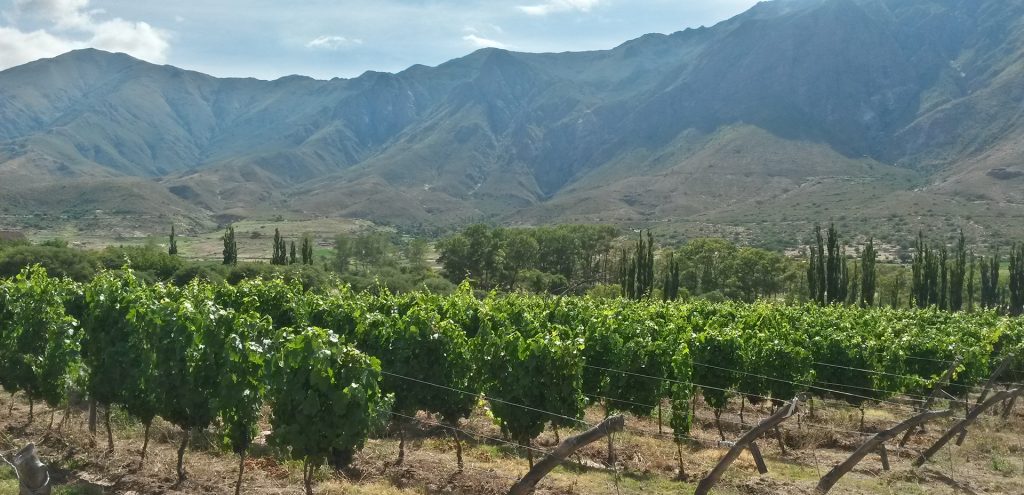The northwest of Argentina offers several outstanding and unique examples of winemaking in extreme conditions. The vineyards of the Calchaquí Valleys are planted and maintained at altitudes ranging between 1700 and 3100 meters above sea level (masl).
The dry, extremely sunny days contrast sharply with the cold mountain nights resulting in a thermal range double that of any other winemaking region in the world. The combination is a severe test of the adaptability of the vines and shapes their distinctive high altitude character.
Recently the winemaking heritage of the region has been re-examined by new generations looking to try out different approaches to high altitude wines.
Calchaquí Valleys´ hotspots
Up until the early 2000s, the Calchaquí wine industry was located almost exclusively in the Cafayate Valley and the area still boasts the most hectares under vine. Here, the pioneers of high altitude winemaking produced intense, profound wines for which grapes were allowed to ripen at length resulting in a recognizably local style. These were feisty, potent reds that put northwestern Argentina on the map. The only whites that seemed to be of interest, meanwhile, were deep, floral Torrontés.
However, over the past twenty years, vines have sprung up in even higher areas than Cafayate with historic locations such as Molinos, Tacuil and Cachi making important contributions to the fine tuning of high altitude wines. ‘Today, we’re not looking to bring out the power of the grapes but rather the elegance, complexity and purity of each Calchaquí terroir,’ says Raúl Dávalos, whose Valle Arriba wines are the result of his exploration of areas such as Seclantás (2200 masl), Pucará (2400 masl) and Luracatao (2600 masl) in addition to Tacuil, the historical family seat; an iconic winery among high altitude wines set at 2600 meters above sea level.
‘These extreme regions encouraged us to try out harvesting methods that differed from those in Cafayate,’ says Agustín Lanús, another explorer of the Calchaquí Valleys´ extreme fruit and vines. ‘The terroir and nature showed us that we could harvest earlier without losing the local character, and these methods were gradually adopted in Cafayate and the surrounding area.’
And so a wave of new wines appeared from single vineyards or a combination of grapes from different parts of the region that reflect more the freshness brought by the altitude than the potency seen in previous vintages.
‘The change of harvest times (bringing them forward) and the work with the vines to protect grapes with foliage were a couple of the practices we implemented to produce more elegant wines without losing our identity,’ says Francisco Puga, the winemaker responsible for the change of style seen in the Porvenir de Cafayate label and creator of a line of family wines that are now some of the best in the Calchaquí Valley.
New generations, new wines
Focused on the production of high end wines, Calchaquí Valleys´ winemakers have always been ready to test their vines to the limit to get the best out of them. Today, however, the goal is to achieve greater elegance and gentleness without betraying the natural characteristics of the terroir.
Among the changes we’re seeing is reduced reliance on Malbec, Cabernet Sauvignon and Torrontés. Be it in Cafayate, Tolombón or Payogasta, there are now a lot more options among both whites and reds.
One important trend is the rediscovery of Criolla grapes from old, almost forgotten parral vines. It was lead by Alejandro Pepa at Bodega El Esteco with his Criolla Old Vines and there are now a dozen other examples including Vallisto, Sunal Ilógico and Valle Arriba La Criollita.
Quintessentially Calchaquí blends are also appearing: refined wines such as Chañarpunco from El Esteco and L’Amitie Grand Vin from Francisco Puga offer surprisingly Burgundy-like qualities.
When it comes to Malbec, the changes in winemaking methods have resulted in a more svelte expression but more refreshing feel thanks to the high altitude, as can be seen in Colomé Altura Máxima, Laborum Parcela Alto Río Seco from Porvenir in Cafayate, Estancia los Cardones or the most recent vintages from Amalaya.
Finally, high altitude Torrontés have grown less terpenic and more citrussy and floral, especially the versions produced by Terrazas de Los Andes, El Esteco and Abras.
However Sauvignon Blanc is also starting to earn a place for itself as seen in wines such as RD from Tacuil and Altupalka Extremo, both produced at 2600 masl at the Tacuil winery, and Colomé Lote Especial, made with grapes from the Altura Máxima vineyard at 3111 masl.
And so, while winemaking frontiers are spanning ever greater latitudes, in the northwest of Argentina, altitude has been the key factor in rediscovering the potential of one of the most amazing and beautiful viticultural regions on the planet.



